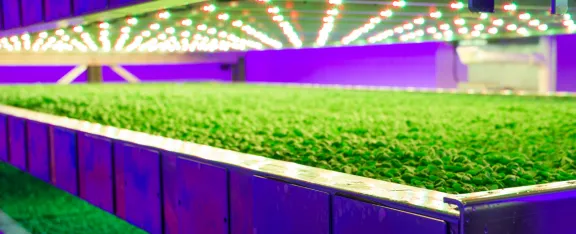What is Vertical Farming?
Vertical farming is the practice of growing food crops stacked in vertical layers. In vertical farming, crops are grown indoors under LED lights and using soil-less methods such as hydroponics, aquaponics and aeroponics. Vertical farming aims to produce more food in less space.
Vertical farming is on the rise in Scotland thanks to climate innovators like IGS.
We covered Vertical Farming in our recent Spark of Science episode - click here to revisit.
Who are IGS?
Founded in 2013, Intelligent Growth Solutions (IGS) is a agri-tech company based in Scotland. The IGS Crop Research Centre, which was brought about in collaboration with the James Hutton Institute, is Scotland’s very first vertical farm and is located just outside of Dundee.
Their award-winning products are internationally recognised. They have developed fully-automated 'Growth Towers' which allows for year round food production in a controlled climate.
For more information visit their website here.
Will vertical farming take place of traditional farming?
Whilst vertical farming will play an important role in how we produce food in the future, it will not take the place of traditional farming. Modern agriculture will have to face the possibility of land shortages, water scarcity and growing populations to feed in the future. Vertical farming can help to alleviate some of these challenges.
Why is vertical farming important?
Vertical farming has the serious potential to address areas of global agricultural and environmental need with a committed and innovative community driving its adoption.
Across the globe there are major challenges driving the need for an urgent transformation in how we produce and distribute food.
It is predicted that the world population is expected to go from 7.6 billion today to 8.6 billion in2030, and 9.8 billion in 2050. It is imperative that we find ways to feed this population easily, sustainably and with quality produce.
The mass adoption of indoor farming will be fundamental to achieving this. Crops can be grown closer to the point of consumption and/or distribution, so reducing freight costs and food miles whilst increasing shelf life combine to deliver a significant decrease in wastage.
By growing crops closer to the market in controlled vertical farming conditions, it is possible to accurately predict and grow to market demand, resulting in a reduction in food waste.
Plants grown in a vertical farming environment should be free of pesticides; free of diesel-powered vehicles; water should be constantly recycled and crops not washed in chlorinated water. It eliminates crop losses due to weather, disease, drought and pests. It means we can grow healthier, more nutritious foods at economically viable prices.
The controlled environment has the capacity to control quality, taste and flavour, and enable fresher produce with a longer shelf life. The environment helps alleviate crop losses due to weather, disease, drought, or pests.
Glasgow Science Centre's new permanent exhibition, Idea No59 celebrates the innovative spirit in us all. On your next visit, come and explore the exciting process of taking ideas and bringing them to life.



